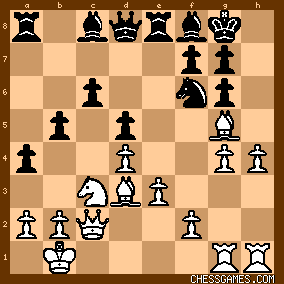| KEG: The Tournament Book suggests that this game--in which Mason attacked on the King's side and Janowski on the Queen's side--was decided by a one-move blunder by Janowski on move 19 (19...b4). Fritz says that Janowski was lost before move 19 and the 19...b4 was no mistake at all but his best chance. Who is correct?
It must be recalled that this game was played in Round 11 of the London 1899 tournament, one round after Janowski--who had been burning up the field until then--lost to Lasker. Janowski had been playing brilliantly until his defeat by Lasker, After that loss, he was defeated by Mason here and by Bird in the following round. A review of the game suggests that Janowski was not himself and was recklessly forcing play and making bizarre moves. Was he still shaken from the Lasker game? Beginning with his 15th move, Janowski played as if he thought he should be able to blow Mason off the board. As a result--at least as I see it--Janowski made a series of overoptimistic moves that got him in trouble, and then made matters worse for himself by needlessly sacrificing the exchange. I do not think that this is a game lost by a single blunder. In short, I side with Fritz. Mason had come out of the opening with a slight edge, but then played 13. g4. The Tournament Book suggests that Mason was trying to prevent Janowski from playing Nh5. In fact, the move compromised his position. After Mason's 15. Bg5, the position was as follows: 
click for larger viewMason certainly had no advantage in this position, and with 15...Be6 Janowski would have had a good game. Instead, and for reasons I cannot fathom, Janowski played 15...Bf8. The Tournament Book says that Janowski was trying to make room for his Queen to move to d6. I don't get it, and neither does Fritz which rated Mason as (0.49) after 15...Bf8. After this strange defensive more, Janowski began a Queen-side pawn advance with 16...b5, 17...a5, and then 18...a4 (which Fritz identifies as the losing move). Meanwhile, Janowski ignored Mason's advance on the King-side. After Mason's 19. h4, the position was thus:

click for larger viewJanowski here played 19...b4. The Tournament Book says this was "a regrettable oversight." Fritz says that Janowski was lost by now, and this was his best chance at counterplay. I side with Fritz on this. Unlike Mason, Janowksi had not placed his pieces to be able to support his Queens-side advance. His pawn sac with 19...b4 gave him some chances. His follow-up, however, was poor. His second pawn sacrifice (25...c5) was neither necessary nor justified. After Mason's 30. exd4, things certainly looked bad for Janowski: 
click for larger viewDown two pawns and with Mason holding the only passed pawn, Janowski decided that desperate measures were required, and so sacrificed the exchange with 30...RxB. This gave him only a momentary attack, and Mason soon got himself a running b-pawn by sacrificing his a-pawn with a4, and the game was over very shortly. Perhaps Janowski's best shot in the last diagrammed position was 30...Bc5. In fairness to Janowski, however, it is doubtful if there was any way to save the game. Having enjoyed Janowski's excellent play during the first nine rounds in this Tournament (in which he scored 7.5 out of 8), and being bewildered by Janowski's bizarre play throughout the present game, I think this game was the result of a hangover from his Round 10 encounter with Lasker. | 




